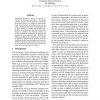EMNLP
2009
13 years 10 months ago
2009
The work presented in this paper explores a supervised method for learning a probabilistic model of a lexicon of VerbNet classes. We intend for the probabilistic model to provide ...
EMNLP
2009
13 years 10 months ago
2009
We present a discriminative substring decoder for transliteration. This decoder extends recent approaches for discriminative character transduction by allowing for a list of known...
EMNLP
2009
13 years 10 months ago
2009
We use the technique of SVM anchoring to demonstrate that lexical features extracted from a training corpus are not necessary to obtain state of the art results on tasks such as N...
EMNLP
2009
13 years 10 months ago
2009
EMNLP
2009
13 years 10 months ago
2009
Methods that learn from prior information about input features such as generalized expectation (GE) have been used to train accurate models with very little effort. In this paper,...
EMNLP
2009
13 years 10 months ago
2009
Unknown lexical items present a major obstacle to the development of broadcoverage semantic role labeling systems. We address this problem with a semisupervised learning approach ...
EMNLP
2009
13 years 10 months ago
2009
Coreference systems are driven by syntactic, semantic, and discourse constraints. We present a simple approach which completely modularizes these three aspects. In contrast to muc...
EMNLP
2009
13 years 10 months ago
2009
EMNLP
2009
13 years 10 months ago
2009
Current statistical machine translation systems usually extract rules from bilingual corpora annotated with 1-best alignments. They are prone to learn noisy rules due to alignment...
EMNLP
2009
13 years 10 months ago
2009
In this paper, we address the task of crosslingual semantic relatedness. We introduce a method that relies on the information extracted from Wikipedia, by exploiting the interlang...



